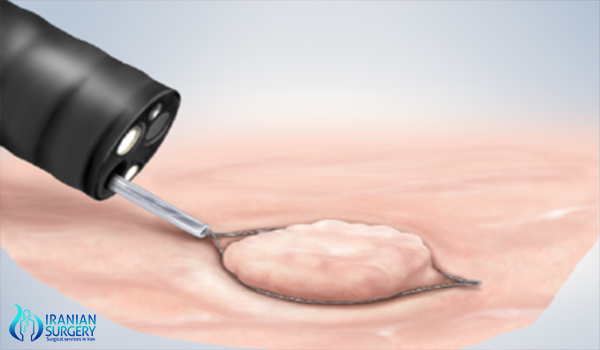Polypectomy surgery in Iran

Polypectomy surgery in Iran
Over viewA polypectomy is a procedure used to remove polyps from the inside of the colon, also called the large intestine. A polyp is an abnormal collection of tissue. The procedure is relatively noninvasive and is usually carried out at the same time as a colonoscopy.
What’s the purpose of a polypectomy?
Many tumors of the colon develop as a benign (noncancerous) growth before becoming malignant (cancerous).A colonoscopy is first done to detect the presence of any polyps. If any are detected, a polypectomy is performed and the tissue is removed. The tissue will be examined to determine if the growths are cancerous, precancerous, or benign. This can prevent colon cancer.
Polypectomy surgery cost in Iran
What affects the final cost of Polypectomy?Technology usedType of anesthesia or sedationQualifications/expertise of specialistTreatment methodAdditional fees for imaging or testsPolypectomy surgery cost in Iran starts from $480.
Sign and symptoms
Polyps aren’t often associated with any symptoms at all. However, larger polyps may cause:rectal bleedingabdominal painbowel irregularitiesA polypectomy would help relieve these symptoms as well. This procedure is required any time when polyps are discovered during a colonoscopy.
Before polypectomy surgery
Many tumors of the colon develop as a benign (noncancerous) growth before becoming malignant (cancerous).A colonoscopy is first done to detect the presence of any polyps. If any are detected, a polypectomy is performed and the tissue is removed. The tissue will be examined to determine if the growths are cancerous, precancerous, or benign. This can prevent colon cancer.Polyps aren’t often associated with any symptoms at all. However, larger polyps may cause:rectal bleedingabdominal painbowel irregularitiesA polypectomy would help relieve these symptoms as well. This procedure is required any time when polyps are discovered during a colonoscopy.
During polypectomy surgery
A polypectomy is usually carried out at the same time as a colonoscopy. During a colonoscopy, a colonoscope will be inserted into your rectum so your doctor can see all segments of your colon. A colonoscope is a long, thin, flexible tube with a camera and a light at the end of it.A colonoscopy is offered routinely for people who are over 50 years old to check for any growths that could be indicative of cancer. If your doctor discovers polyps during your colonoscopy, they’ll usually perform a polypectomy at the same time.There are several ways in which a polypectomy can be performed. Which way your doctor chooses will depend on what kind of polyps are in the colon.Polyps can be small, large, sessile, or pedunculated. Sessile polyps are flat and don’t have a stalk. Pedunculated polyps grow on stalks like mushrooms. For small polyps (less than 5 millimeters in diameter), biopsy forceps can be used for removal. Larger polyps (up to 2 centimeters in diameter) can be removed using a snare.In snare polypectomy, your doctor will loop a thin wire around the bottom of the polyp and use heat to cut the growth off. Any remaining tissue or stalk is then cauterized.Some polyps, due to a large size, location, or configuration, are considered more technically challenging or are associated with an increased risk of complications. In these cases, endoscopic mucosal resection (EMR) or endoscopic submucosal dissection (ESD) techniques can be used.In EMR, the polyp is lifted from the underlying tissue using a fluid injection before resection is performed. This fluid injection is often made of saline. The polyp is removed one piece at a time, called piecemeal resection. In ESD, fluid is injected deep in the lesion and the polyp is removed in one piece.For some larger polyps that can’t be removed endoscopically, bowel surgery may be needed.Once a polyp has been removed, it’ll be sent to a pathology lab to test if the polyp is cancerous. The results usually take one week to come back, but sometimes can take longer.
Preparing for a polypectomy surgery in Iran?
In order to perform a colonoscopy, your doctors need your large intestine to be entirely clear and free from any visual obstruction. For this reason, you’ll be asked to thoroughly empty your bowels for one or two days prior to your procedure. This might involve using laxatives, having an enema, and eating a clear food diet.Just before the polypectomy, you’ll be seen by an anesthetist, who’ll administer anesthetic for the procedure. They’ll ask you if you’ve had any bad reactions to anesthetic before. Once you’re ready and in your hospital gown, you’ll be asked to lie on your side with your knees pulled up to your chest.The procedure can be done relatively quickly. It usually only takes between 20 minutes to 1 hour, depending on any necessary interventions.
How long does it take to recover?
You shouldn’t drive for 24 hours following a polypectomy.Recovery is generally quick. Minor side effects such as gassiness, bloating, and cramps usually resolve within 24 hours. With a more involved procedure, a full recovery can take up to two weeks.Your doctor will give you some instructions on how to care for yourself. They may ask you to avoid certain drinks and foods that can irritate your digestive system for two to three days after the procedure. These can include:teacoffeesodaalcoholspicy foodsYour doctor will also schedule you for a follow-up colonoscopy. It’s important to check that the polypectomy was successful and that no further polyps have developed. What are the complications and side effects?The risks of a polypectomy can include perforation of the bowel or rectal bleeding. These risks are the same for a colonoscopy. Complications are rare, but contact your doctor immediately if you have any of the following symptoms:fever or chills, as these could indicate an infectionheavy bleedingsevere pain or bloating in your abdomenvomitingirregular heartbeat
What are the complications and side effects?The risks of a polypectomy can include perforation of the bowel or rectal bleeding. These risks are the same for a colonoscopy. Complications are rare, but contact your doctor immediately if you have any of the following symptoms:fever or chills, as these could indicate an infectionheavy bleedingsevere pain or bloating in your abdomenvomitingirregular heartbeat
10 common Questions about polypectomy surgery
Is it painful to have polyps removed?: Having a cervical polyp removed is not painful, however, you may feel mild discomfort similar to period pain afterwards. If you are uncomfortable, a mild painkiller will be offered to you.
Is polypectomy painful?: Polyps are usually not cancerous, but they can change into cancer over time, and that is why they need to be removed. ... Some patients worry that a polypectomy may be painful, but Dr. Gelrud and Dr. Echavarria explain that polyps and the colon lining contain no nerves, so you won\'t feel pain during removal.
What can you eat after polyp removal?: If you had a polyp removed, your doctor may recommend additional dietary guidelines for you.
...
What not to eat after a colonoscopy
alcoholic beverages.
steak, or any type of tough, hard-to-digest meat.
whole grain bread.
whole grain crackers, or crackers with seeds.
raw vegetables.
corn.
legumes.
brown rice.
What happens after polyps are removed?: Most polyps found during colonoscopy can be completely removed during the procedure. ... Because the bowel\'s lining isn\'t sensitive to cutting or burning, polyp resection doesn\'t cause discomfort. Resected polyps are then examined under a microscope by a pathologist to determine the tissue type and to detect any cancer.
Do I have to have uterine polyps removed?: Once identified, polyps can be removed surgically through a hysteroscopy. ... It\'s possible that you might need to undergo treatment more than once if you experience recurring uterine polyps. If the polyps are found to contain cancerous cells, hysterectomy (removal of the uterus) becomes necessary.
Can periods return after endometrial ablation?: Can heavy periods come back after endometrial ablation? It\'s possible that your heavy periods may return after having endometrial ablation. Ablation works by destroying the lining of your womb. Sometimes after the operation, some women find that their periods don\'t stop completely, though they may be lighter.
What are the early signs of uterine cancer?: Signs and symptoms of endometrial cancer may include:
Vaginal bleeding after menopause.
Bleeding between periods.
An abnormal, watery or blood-tinged discharge from your vagina.
Pelvic pain.
Can the lining of the uterus grow back after an ablation?: Endometrial ablation is a permanent procedure. Your uterine lining won\'t grow back afterward. This procedure is helpful for many women, but isn\'t recommended for everyone.
How long does it take to recover from a polyp removal?: about 2 weeks
Recovery from a polypectomy usually takes about 2 weeks. Patients may feel pain following the procedure, particularly immediately after the procedure.
How often do you need a colonoscopy if you have polyps?: But even a very good test can be done too often. Here\'s when you need it, and when you might not. Having a colonoscopy more than once every five or ten years usually isn\'t necessary. A grape-like growth, or polyp, in the colon or rectum is common in adults and usually harmless.
10 common Questions about polypectomy surgery
[kkstarratings]



